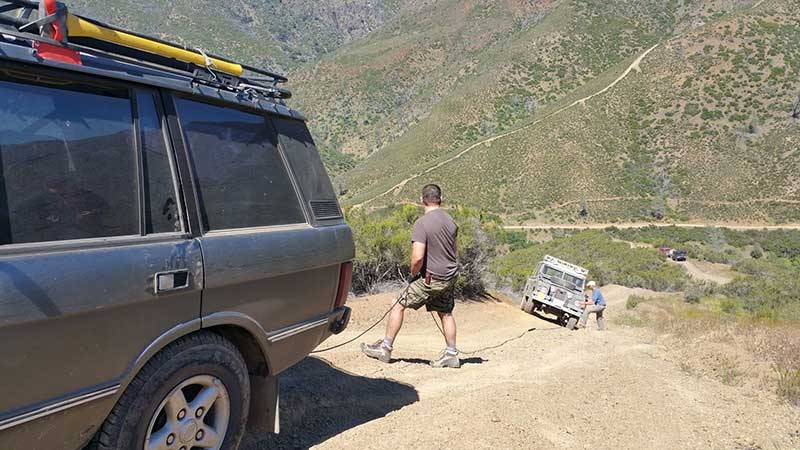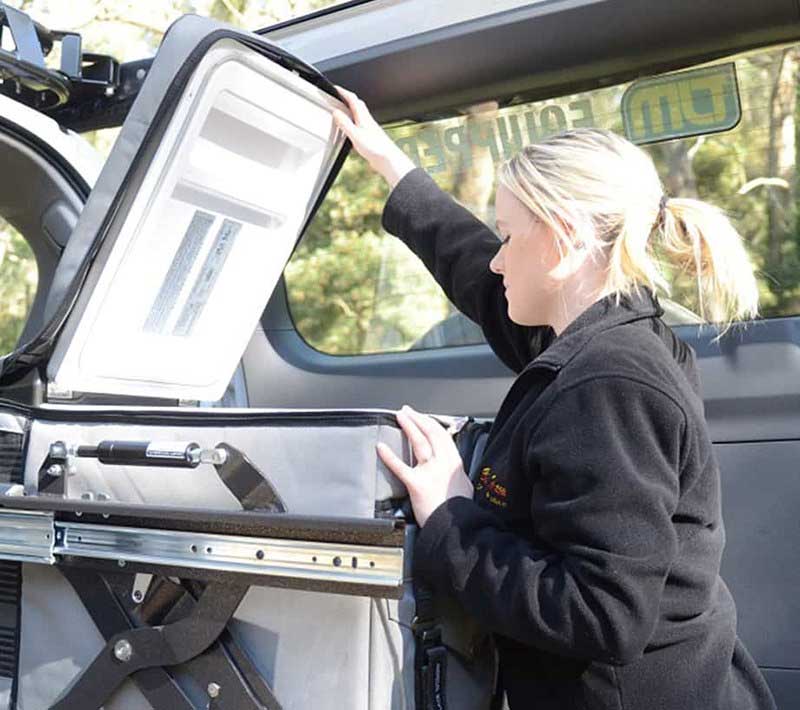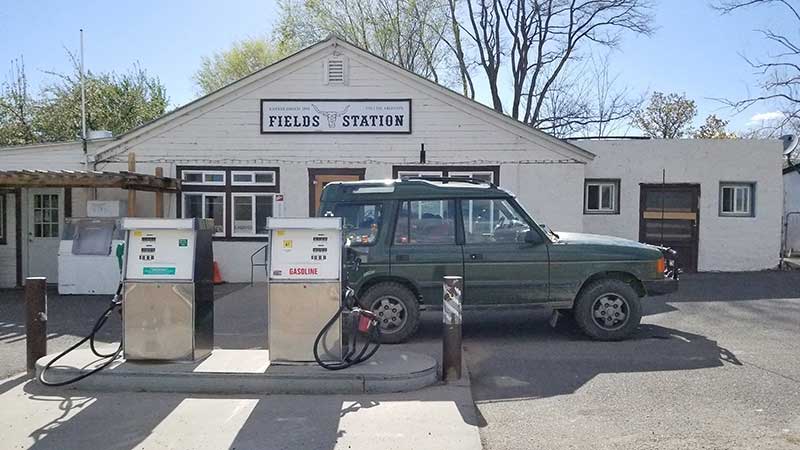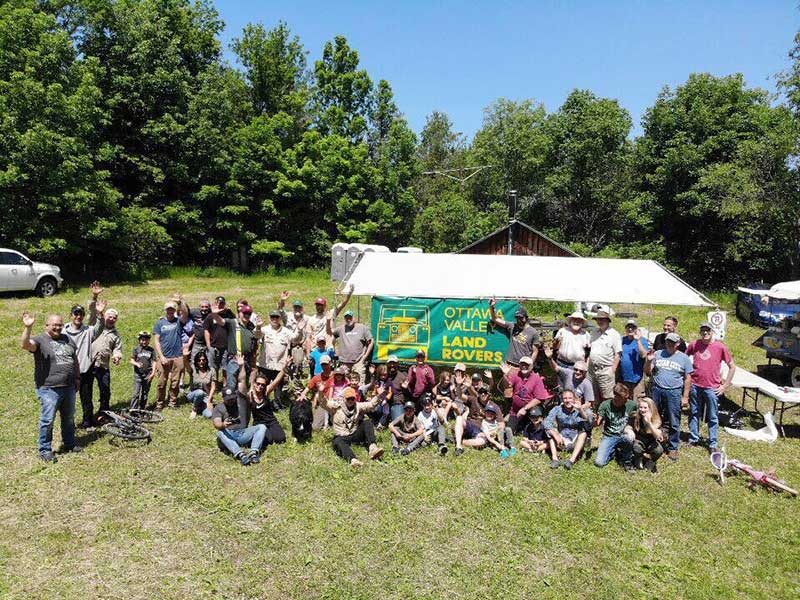Looking at accessories on the Internet is like being a kid flipping through a toy catalog – you want everything. But what do you really need to do to get started on vehicle-dependent backcountry adventure?
Atlantic British has been supplying Land Rover owners and overlanders on expeditions around the globe for half a century. In our view, a Top 10 list of overland prep starts like this.
1. A Well-Maintained, Capable Vehicle
The vehicle is the core of vehicle-dependent adventure, and if you’re going to be relying on it in the backcountry, it needs to be in good shape. Any breakdown that happens at home is exponentially more complicated and stressful to fix in the field.
Make sure that you’ve kept up with your maintenance schedules. Before you leave, check all of the fluids in the vehicle – including the differentials, transmission, and transfer case, if they are equipped to be user-serviceable. Check for both fluid level and cleanliness. If you’re going to hit your oil change interval on the trip, change it preemptively before you leave.
Make sure your truck’s engine is in tune, and that any warning lights and codes are cleared. The abuses of off-roading may exacerbate an issue you’ve been nursing along during your daily driving. Get underneath your truck and make sure that the steering and suspension links are all correctly tightened, and are not worn out. If one of these breaks on the trail, you could be in for a world of hurt. Make sure your brakes are operating safely, and that your pads have enough life left in them. Brakes are critical off-road, where a failure could be the literal line between life and death.
Also, make sure your tires are not worn and are an appropriate tread pattern for your destination. Worn out street tires will be useless in the mud. An all-terrain tire is a good compromise for daily use and overlanding, while a mud tire has benefits in some regions for a more trail-focused vehicle.
2. Spare Parts and Tools
Every off-road vehicle has weaknesses, even the most mighty Land Rover. Fortunately, these faults are usually well-documented on the Internet and are known by respected parts suppliers. Many of them are also small items, which can easily be shoved in a seat pocket. Spare belts, major coolant hoses, spare universal joints, and certain sensors are often relatively cheap insurance.
It’s also important to have tools and the know-how to use them. There are some special tools that can make life easier. For example, fixing driveline issues on earlier Land Rovers is easier with special driveshaft nut sockets that fit inside the driveshaft yoke. For later models, a OBD-II port-based diagnostic tool like the iLand diagnostic tool and app is a huge help for field diagnosis.
Make sure your jack works, and your lug nut wrench is functional and present. You should always be able to remove your lug nuts with hand tools on the trail. Some mechanics will over-torque wheels with air tools that make it almost impossible to remove them by hand. If you can’t remove them by hand, undo them with power tools at home and reinstall them the right way.
3. Recovery and Emergency Equipment
It’s relatively easy to get stuck on the trail. What’s a little harder is getting unstuck. You should never venture onto the trail without, at minimum, a recovery strap and a safe way to affix it to both your vehicle and the recovering vehicle. There’s a myriad array of shackles to do that – both traditional metal “hard shackles,” and synthetic winch line-based “soft shackles” that don’t become dangerous projectiles if the recovery strap fails.
If you’re winching, consider using a tree strap to protect both the tree and the line – they have extra padding that will protect the strap from chafing on the bark.

You should always pull with securely affixed recovery points, using equipment with a working load limit that is safe for the weight of the vehicle being recovered. More than a few people have been killed or seriously injured from using inferior recovery gear.
Trail jacks by companies like Jackall and Hi-Lift are cool looking tools, and very useful, but they too can be extremely dangerous if used incorrectly. Before you use one, read the directions carefully, and view some YouTube videos on safe operation. They store an immense amount of potential energy under load.
Winches are great, but also need to be treated with care. Make sure your rope or cable is well maintained, and only ever attach the winch to another vehicle on a secure, safe recovery point. Never step over the winch line when it is under load. When winching, everyone should be well clear of the cable’s range if it were to snap and ricochet away. That’s why winch remotes have really long cords!
4. First Aid Gear
You don’t need to open a Doctors Without Borders field hospital in your truck, but a basic first aid kit is important to have in the wild. Bandages, ointments, and basic painkillers can solve a lot of issues on the trail. Of course, remember to pack prescription medication, too. If you have a medical condition that may require having to get into civilization relatively quickly in an emergency, plot out where the nearest hospitals are to the trailhead ahead of time.
5. Refrigeration and Water
First off: you don’t need a refrigerator to go on your first overland adventure. A cooler will be fine for a short journey. Just make sure you can keep on top of replenishing ice; the new injection-molded coolers extend the lifespan of ice significantly. However, when it comes to keeping food temperature constant, nothing beats a 12-volt fridge. They also allow you to carry a lot more food in the same space since the compartment isn’t taken up with ice.
Off-road focused refrigerators tend to be made out of heftier components, which can take the abuse of the jolts and vibrations of the trail that an RV-style model cannot. One other thing about them: they tend to be top-loading, which makes it difficult for some people to access them in lifted off-road trucks. The Clearview Easy Slide lowering slide mount the fridge down and out to your level, making it much easier to use and access.

The other life essential is water, and you should always carry plenty of it. There are heavy-duty water containers, such as those made by Wavian, which can survive the jostling of an off-road environment without cracking and leaking. Keep in mind that you need to carry water for drinking and household use. If you’re in the desert, you should carry a gallon per person, per day (and drink it). On top of that you need water for washing dishes and cooking, and all the other things it is used for. Do the math, and carry a little extra if you’ll be far off the grid. Reuseable water bottles are great to keep with the driver and passengers. Make a routine out of drinking and refilling them every few hours to stay hydrated and healthy.
6. Vehicle Protection
Your truck doesn’t need to be turned into a tank to go on a beginning off-road adventure, but over time, armor is good to add to beef up weak points. Differential guards can keep a stray rock from puncturing a differential casing. Skid plates protect vital organs underneath and allow you to grind over them if needed. Heavy-duty steering rods keep your wheels straight. Rock sliders and sill protectors keep your body straight and your doors closing correctly.
Heavy-duty steel bumpers, when available, can be one of the best upgrades. Not only do they protect the front and rear of the vehicle, but they also are stronger mounting locations for recovery points. They are also usually designed to accept a winch and are the easiest way to add one to your vehicle. They also can improve approach and departure angles by negating air dams that take up valuable ground clearance.
Just keep in mind that armor is heavy and counts against your gross vehicle weight rating. A few hundred pounds of armor will increase stopping distance, reduce your safe payload capacity, and will cause significantly more damage to other vehicles in an accident. A heavy-duty bumper will protect your vehicle, but it may turn a fender bender into a total write-off for the other party in a crash. That winch bumper carries the extra responsibility to drive a little more carefully.
7. Cargo Storage
Your truck will be carrying all of your worldly needs for the duration of your trip, so as much as you treat your truck with respect, treat your gear with respect, too.
Roof racks look awesome, but they have to be used with care. They will inherently change the center of gravity of your vehicle and will impact fuel economy. They’re a good place for lightweight, bulky items, but whatever you put up there, always keep in mind that you have to respect the laws of physics. Also, don’t put anything too valuable up there if you are concerned about theft.
The laws of physics also apply inside the vehicle. Make sure that all of your cargo has a place to live where it won’t jostle around, or worse, fly around in a more spirited off-road situation – or a crash. Heavy items in the back should be secured in some way, either via straps or behind a guard of some sort. In a collision, a loose toolbox could become a deadly projectile.
8. Fuel
You don’t need to carry fuel with you everywhere, as cool as a jerry can looks strapped to the truck. But it can be essential in certain locations, such as longer trails in the western United States, or some remote parts of Maine and Canada. It can also be useful in some vehicles with a smaller fuel capacity and thus shorter range. You also don’t get the same fuel economy off-road as you do on the Interstate – sometimes you can even halve your economy on an older, less-efficient-overall 4x4 once you hit the trail.

Once you have your rough route figured out for your overland adventure, do some math and see how far your built-in fuel tank can get you before you hit the next gas station. Anything above that needs to be covered with auxiliary fuel, and you should always have a contingency. You may hit a trail blockage at the end of the trail and have to backtrack the entire length of it, or that rural gas station may be closed. Make sure you’re prepared with fuel to do that. Quality jerry cans and accessories are a must to carry and use extra fuel safely and securely.
9. Maps and Guidebooks
Cell signal disappears rapidly in the backcountry, and GPS phone apps like Waze aren't very useful on the trail. The best solution? An arsenal of maps, both high-tech and low-tech. There are some great mapping apps for phones and tablets, like Avenza and Topo GPS. You can download a variety of different maps into these apps, from topographic maps to trail maps. You can also use standalone GPS receivers, and download detailed topo maps into them for tghe area you are travelling to and through.
It’s always good to have a paper backup and a good compass, too, just in case. DeLorme and Benchmark make great gazetteers, which give you a close-up look at the entirety of a state. Topographical maps of National Parks and other popular destinations are available from mapmakers like National Geographic. National Forests have a Motor Vehicle Use Map, part of every forest's legally-required Travel Management Plan, and often you can obtain these maps free from ranger stations, and can download them online.
There are also many excellent regional off-road guidebooks available, especially in the western US. These give details of different trails, including explanations of the obstacles and natural and historic sites along them. If you plan to visit a region frequently, they’re a great investment to understand the area more. Overlanding is even more fun when you have a cultural and natural context for an area.
10. Community, Training, and Safety
Off-roading is just more fun with friends. It’s also significantly safer to go out on the trail in groups, especially if you are a beginner off-roader and can learn as you go from seasoned veterans. Every brand of 4x4 has a number of clubs, and there’s plenty of brand-neutral and overland-focused clubs, too. Land Rover clubs are full of particularly good people. Check out our list of North American Land Rover clubs here.

It's great to have all of your new overland accessories strapped to your truck, but if you are uncomfortable driving off-road, you still won't have that much fun. There's lots of ways you can prepare yourself before your first trip out on the trails. There's lots of YouTube videos to teach you off-roading techniques, and watching a few of them will help. Of course, an off-road club is a great way to learn, going out on the trail with seasoned veterans. (Just don't choose a trail run that's too advanced for your first time.)
There's lots of professional off-road training available too, including International 4 Wheel Drive Trainers Association (I4WDTA) instructors and the Land Rover Experience Driving School at select North American regional resorts. Professional trainers can teach you driving techniques for different kinds of terrain, the proper and safe use of recovery equipment, how to navigate off-road, and basic trailside repair and maintenance techniques. Don't let a lack of knowledge and training get you stranded -- as the Boy Scouts say, "be prepared!"
Overlanding takes a bit of preparation, more than your typical road trip. It also requires a skill set that goes beyond just knowing how to drive a vehicle off-road. However, with proper preparation, it can be an immensely rewarding way to travel.






















